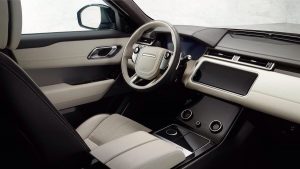Larger than an Evoque and smaller than a Range Rover Sport, the Velar is a new way into Range Rover ownership, with rivals including the Porsche Macan and Audi.
The Range Rover Velar is a stylish and very capable SUV geared more towards comfort than excitement. It’s not perfect, and those looking for a scintillating drive may prefer a Porsche Macan or Jaguar F-Pace. But it certainly lives up to the Range Rover name, and reflects the image and user experience of its full-sized sibling.

The styling of the Velar is an evolution of the looks found on other Range Rover-branded cars (those being the full-sized Range Rover, the Range Rover Sport and the smaller Range Rover Evoque). That makes it distinctive and contemporary, aided by plenty of eye-catching details, such as the door handles that retract flush with the bodywork when the car is in motion. Different versions of the Velar have different styling, with four different headlight designs – all of which are LED – and more aggressive bumpers for R-Dynamic models. Land Rover offers plenty of personalisation options, with 13 paint colours and alloy wheels ranging in size. Standard cars ride on 18-inch wheels, while S models get 19s, SE cars have 20s and HSE models sit on 21-inch rims. Massive 22-inch wheels are optional.
The Velar’s interior design follows a minimalist theme, with as much clutter removed as possible. The centrepiece is the standard dual-touch-screen infotainment system, a system that looks seriously cutting edge and is hugely customisable to your preferred set-up. We’ve found it slightly confusing to navigate based on our first interactions, but we’ve not yet had the chance to spend serious time with it. We also found that the touch-screens quickly became covered in fingerprints, and while they look great, they’re often not as easy to use as a combination of buttons and dials. SE cars and above get a 12.3-inch screen in place of traditional instrument dials, which looks great and can again be configured in plenty of ways, depending on the information you want displayed. The high-specification models we drove were covered in some luxurious leather on the seats and dashboard, but it’s a shame though that some of the plastics used – such as those on the glovebox lid and centre armrest – aren’t as solid or as tactile as we’d hoped. While the cabin is a very pleasant and comfortable environment in which to sit, it doesn’t have the bullet-proof sense of quality possessed by the Audi Q5.
Stick the words ‘Range Rover’ on the back of a car, and you conjure up expectations of wafting comfort with solid handling. And on these, the Velar largely delivers. It focuses more on waftiness than excitement, and with the air suspension that’s fitted as standard on V6-powered models, it filters out road imperfections very well. The exception is on cars fitted with 22-inch wheels; we found that these crash and bash over rough surfaces in a way that smaller wheels don’t. Despite the comfort focus, the handling is remarkably solid, with excellent control around corners and minimal body roll. However, the payoff for the soft ride is a bit of pitching back and forth if you brake or accelerate hard. This isn’t a car that urges you to drive enthusiastically, though, and instead delivers a relaxed, confident experience. Models with four-cylinder engines come with a more conventional coil spring suspension, which we’ve yet to try. Being a Land Rover product, the Velar also excels off-road, with lots of clever technology to haul it up and down far more challenging terrain than most owners will ever need to tackle. Suffice to say, it’ll easily cope with muddy fields and gravel tracks.
There are several petrol and diesel engine options available on the Velar, all matched to an eight-speed automatic gearbox. So far, we’ve only tried the most powerful options: the D300 diesel V6, and the P380 petrol-powered V6 (can you tell what the ‘D’ and ‘P’ stand for?). Both are excellent, although their performance comes at the expense of fuel economy. The diesel delivers an effortless response with no need to rev it hard for swift progress, and while the petrol delivers its maximum grunt at higher revs, it doesn’t struggle lower down. There will also be two smaller diesel engines – the D180 and D240 – and two smaller petrol engines called the P250 and P300.
Many customers are likely to opt for a high-end D300 model, and the R-Dynamic HSE version that we’ve tested is very expensive compared to its rivals, such as a BMW X6 40d M Sport and a Jaguar F-Pace S with the same V6 diesel engine. While the BMW’s resale value is better, the Velar has the edge on other running costs like fuel economy and servicing, and the cost-per-mile for ownership is likely to be almost identical over three years or 60,000 miles. The F-Pace, however, is likely to be cheaper is all areas apart from servicing, with a far cheaper purchase price, better fuel economy and less depreciation. Opt for a mid-range petrol model, such as the P300 SE, and it sits between a lot of the rivals in terms of power. Its price places it alongside the more powerful Macan GTS, while it’s several thousand pounds more than an Audi SQ5 and the difference is even bigger compared with the Jaguar F-Pace Prestige with the same engine. It’ll cost less to fuel and service than the Porsche and the Audi, but the Jaguar will be much cheaper to run overall. Overall, the high purchase prices across the range look very difficult to justify.
Courtesy: AutoTrader.